KEY STEPS OF THE ENTERPRISE SOFTWARE DEVELOPMENT PROCESS
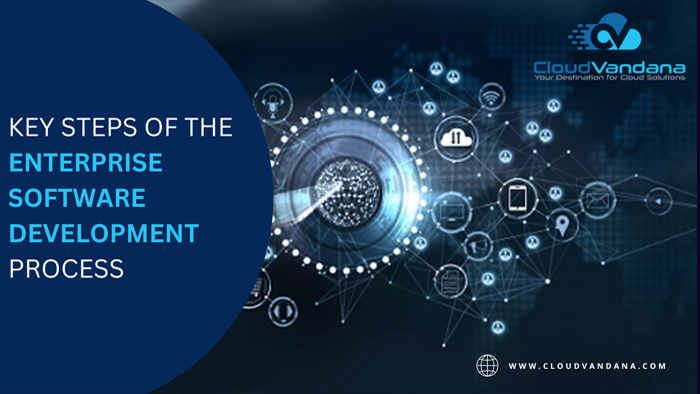
Enterprise Software Development refers to the needs of an organization that already exists, and a system is in place. This development is based on an environment within an organization, which is where it is going to be used and where it is going to meet a goal. In this blog, CloudVandana will discuss the key steps of the enterprise software development process. Most of the time, enterprise software development can be costly and complex for organizations across the globe. So it is essential to plan a proper development process so that the progress can be faster and error-free. Enterprise Software Development, Enterprise software development is the process of creating custom software solutions, especially for a business or organization. This includes enterprise resource planning systems to customer relationship management (CRM) systems. The main focus of creating custom enterprise software solutions is to help businesses optimize their operations, improve coordination among employees, and increase their productivity. Organizations can opt for developing custom enterprise software when they can’t find off-the-shelf software that suits their requirements. Developing custom enterprise software can be complex and costly. So businesses must consider their needs and objectives before implementing a custom software development project. Let’s dive into the details of the enterprise software development process Requirement Gathering Before the main development process, the opportunity should be identified. After identifying the business needs, the process begins with requirement gathering. It is the process of collecting, organizing, and documenting the functional and non-functional requirements of the proposed software system. Professionals like solution architects, business analysts, or persons with similar skill sets can help in this phase by gathering requirements and checking the application portfolio. Proper Planning After gathering all the requirements, it is time to move forward with more detailed software planning and alignment among all parties involved in the software development project. The software development plan outlines the project requirements that will be turned into working software. It covers planning, ideation, development, documentation, deployment, launch, and details. It is recommended to complete the project with a software development team. The team can be either in-house, or organizations can hire an outsourced remote team for better results. UI/UX Design After these steps, organizations can kick off UI/UX design for the new enterprise software. Organizations can complete the UI/UX design by working directly with a full-service software development company or hiring a freelancer. The Development Phase Now, the build phase starts. The software will be built in such a way that it can fulfill all the requirements, and the best projects will ensure continued engagement with end-users throughout the phase. The software development phase is the longest stage in the overall enterprise software development process. The usual time is 6-12 months, depending on the complexity. Testing And Deployment This is an essential stage that ensures the working software is ready to be transitioned into the production environment. This phase is like a gate between development and production, where work is done to ensure the software is meeting all the expectations and design. Post-Launch Maintenance All enterprise systems require some continuous maintenance to ensure they continue to meet all expectations. The support team should always be ready when an issue comes up with the software, or the users face any challenges. So, enterprise software applications should be flexible enough for better scaling, should be well-optimized to streamline business processes, and can easily integrate with Tech Stack. Are you looking for the best team of skilled developers for a successful enterprise software development process? Please feel free to schedule a call with the reputed Staff Augmentation partner CloudVandana and share your requirements. Call us now. Request a Free Consultation YOU MIGHT ALSO LIKE
THINGS TO CONSIDER BEFORE SELECTING THE RIGHT TECH STACK FOR YOUR APPLICATION
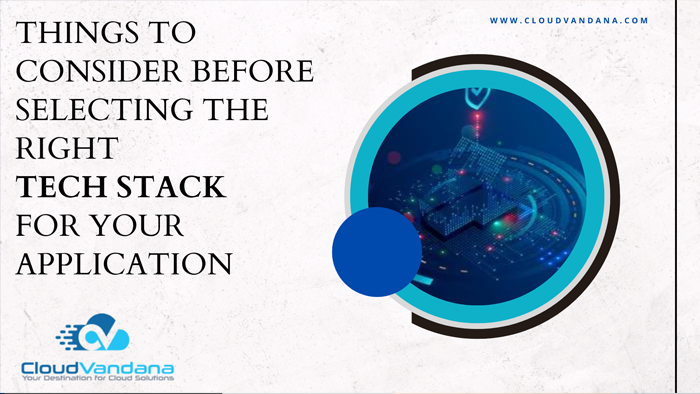
A Tech Stack is the combination of technologies that organizations worldwide use to build and run an application or project. A tech stack consists of programming languages, frameworks, a database, front-end tools, back-end tools, and applications connected by APIs. So selecting the right and robust technology is essential to enhance every app development process. In this blog, CloudVandana will discuss the essential things that organizations should consider while selecting the right Tech Stack for App Development. Tech Stack Or Technology Stack A Technology Stack is a set of technologies developers use to build and run a website. Two major elements are the front and back end, the client and server sides. 1. Front-End Tech Stack This technology is also known as a client-side. It is an important part of a web or mobile application that users generally interact with. Users can see and experience it directly, such as Images, buttons, navigation menu, text styles & colors, tables, etc. It is the latest version of the Hypertext Markup Language. It defines the basic structure of content displayed on a webpage. It is the latest version of Cascading Style Sheets language. It helps to style elements of a web page, such as colors, layout, fonts, etc. It is a scripting language used to make dynamic web pages. Examples of this application are various web animations, color-changing options of a button during hovering, zooming in or zooming out a picture, etc. In addition, there are various other frameworks and libraries, such as Bootstrap, React, Angular, jQuery, and others, that provide additional functionalities and leverage developers to create engaging user interfaces. 2. Back End Tech Stack The back end is a server-side application that is not visible to users. It provides the required support for an application. There are many server-side programming languages available for both web and mobile app development. This includes Python, PHP, Kotlin, Swift, Java, JavaScript, etc. It provides libraries and tools that remove common application development tasks and make the process easier to build, run, and scale. Depending on the programming language selected for back-end development, the framework is chosen. The common and popular server-side frameworks include Laravel(PHP), Node.js (JavaScript), Flutter, and others. The web server stores, Processes, and distributes the coded content to the user as a website or application. The most commonly used servers are Apache, Nginx, and IIS. The database is where the code lives. It stores data that can be requested by the user. Common databases are My SQL, PostgreSQL, SQLite, and MongoDB. The operating system is an interface through which frameworks, servers, and other software components of the tech stack access computing resources required to perform the functions. Common OSs include Windows, Mac OS, Linux, Android, and iOS. Factors To Consider While Selecting The Tech Stack Success depends solely on the technologies that organizations choose. A powerful tech stack serves as a facilitator and helps to meet the requirements. Let’s discuss the top factors. 1. App Size Apps can be categorized into three categories, small-size apps, medium-size apps, and large-size web applications. Small projects require less sophisticated technologies, whereas large projects with complex features like online marketplaces require a tech stack consisting of advanced technologies. 2. Project Requirements The first and foremost aspect is to identify the project’s requirements, like the audience for the app, the target platform, the web or mobile app, and many more. 3. Development Cost The development process is one of the most important factors in determining investment and returns. There are various tech stacks available in the market, so organizations need to select the best one based on their requirements for the best business outcomes. 4. Deployment Deployment is the most crucial step in the development process. Organizations should choose the agile-supported tech stack that can accelerate the development process without affecting the quality. 5. Security Security is a crucial part of any application as they store confidential user data and information, especially for financial firms. Organizations should choose a robust tech stack with fully secured standards that can provide high-end security. 6. Scalability The development process continues after the deployment process, so organizations must choose the technology that is scalable and easy to maintain. These features will help organizations satisfy customers without compromising productivity. Are you looking for a team of skilled developers to manage and deploy your projects successfully? CloudVandana can provide you with the right talent in any technology to keep you one step ahead of your competitors. Schedule a call now and share your requirements. Call Now. Request a Free Consultation YOU MIGHT ALSO LIKE
7 ESSENTIAL TIPS FOR A SUCCESSFUL SALESFORCE CERTIFICATION EXAM

The Salesforce Certification Exam is an essential part of every Salesforce learner who wants to join the Trailblazer Community. So they all get a bit nervous while sitting for this certification exam. So, to overcome this situation, in this blog, CloudVandana, a reputed Salesforce Partner in India, will describe eight essential tips for a successful Salesforce Certification Exam. Tips For A Great Salesforce Certification Exam Let’s look at the effective tips- 1. Learn The Exam’s Objectives Salesforce Certification Exam provides a guideline with all the information that Trailblazers must go through once before the exam day. They should read this guide carefully, paying attention to the exam. The guide has all the details about the exam objectives. The objectives include the following- Knowing the objectives better can lead to a better chance of success. 2. Know Your Testing Style Candidates can either visit one of the testing centers of Salesforce for an onsite exam or can complete the exam remotely, sitting in any part of the world. Candidates can select the best testing option which is most suitable for them. 3. Don’t Sweat The Timer Many people have anxiety regarding time, but the certification exams allow the candidates to control exactly when the test starts for them. The candidates need to complete the exam within a specific time, so the candidates should be well prepared and hit the start button when they are fully ready. 4. Use Memory Shortcuts Candidates should find the various shortcuts that work best for them. Memorizing the order of execution is another important example. As per Salesforce, candidates can use this mnemonic to remember the order of execution: Very Awesome Admins Work Pretty Efficiently, Right? 5. The Power Of Guessing Candidates prepare a lot, so they got quite a bit of knowledge about the Salesforce ecosystem. But in case they face any question that they are not sure about the answer to, it is advisable not to leave the question blank. Instead, an educated guess can be made. Candidates can trust their first instinct, and most of the time, it is likely to be correct. 6. Read, And Reread Being prepared for any examination can be stressful, but candidates should stay calm, take time, and read the entire question carefully. They should read through the entire question and each possible answer properly before committing to an answer. 7. Try And Try Again Through the Salesforce certification program, the learners gain knowledge in a specific area, but not everyone passes every exam on their first try. That is completely okay. Each exam can be considered as one step towards earning the certification. Are you looking for skilled remote Salesforce resources to enhance your Salesforce projects? Please feel free to schedule a free consultation call with CloudVandana and boost your team for a faster and error-free deployment process. Call Now. Request a Free Consultation YOU MIGHT ALSO LIKE
PREDICTIVE ANALYTICS: SALESFORCE MARKETING CLOUD
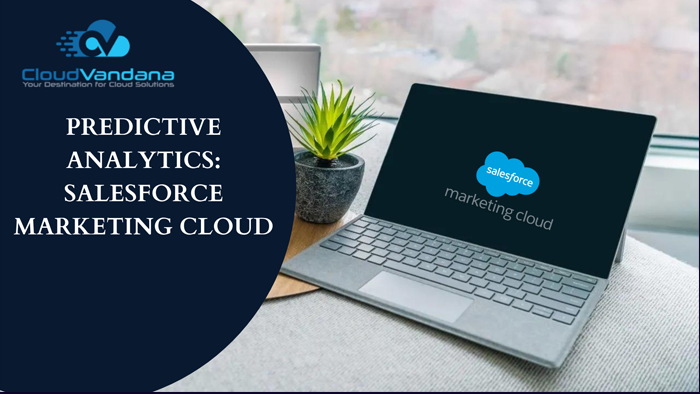
Salesforce Marketing Cloud provides digital marketing automation and analytics software and services. It was introduced in 2000 under the name ExactTarget. The company filed for an IPO in 2007 but withdrew its filing two years later and raised $145 million in funding. Predictive Analysis allows businesses to foresee what is likely to occur in the future by using patterns in the data they already have. In this blog, CloudVandana will discuss Predictive Analytics in Salesforce Marketing Cloud. Effective marketing requires understanding the right audience first and how to communicate depending on their preferences and behavior. Many businesses across the world have started using predictive marketing analytics. The predictive marketing method provides data analytics to identify the marketing plans that have the best chance of being successful. Salesforce Marketing Cloud helps to enhance the power of Predictive Analytics and Predictive Modelling on Salesforce so that users can easily customize and personalize based on their customers’ requirements. Salesforce Marketing Cloud It is a marketing automation software that helps businesses to enhance their effectiveness. Through this platform, marketers can run successful marketing campaigns, create effective management strategies and build healthy customer relationships. It offers organizations a range of analytics and digital marketing automation services. The platform enhances the marketing strategies of the organizations. So organizations worldwide that are using this platform can easily send personalized mass emails to a range of potential clients. Marketing automation can engage customers through several channels, including email, social media, the web, and mobile phones. In addition, it utilizes the information to capitalize on the brand’s online presence. Predictive Analytics With the help of predictive analytics and machine learning, businesses can now analyze a huge amount of data quickly, improving the precision and utility of prediction models. Organizations are now using these data insights to create a personalized journey for customers and increase their sales. Users can segment the audience using predictive analytics based on firmographics, interests, or other factors. Users can develop identification models based on customer data. Web predictive marketing helps websites to transform from a static, one-size-fits-all solution to a more customized and dynamic one. This can be used in email campaigns to send customers customized and personalized communications in their inboxes. Businesses can predict customer behavior across sales, marketing, and service channels by using CRM. Through cross-selling opportunities, businesses can get an overview of their client’s journeys and behavior. So they can provide a customized and personalized solution. Salesforce And Predictive Analytics With Salesforce Marketing Cloud, users can use the power of artificial intelligence to predict customer behavior. The artificial intelligence Einstein analyzes the subscriber base and predicts the engagement across various behavior like-click an E-mail, their likelihood to open an E-mail, unsubscribing from the list, and converting to the website. These behaviors represent a consumer’s likelihood to take action in the next 14 days and are refreshed daily. So, the essential step is to choose the proper predictive analytics model. Are you looking for a reputed Salesforce Partner to experience all the benefits of this CRM platform? Please feel free to schedule a free consultation call with CloudVandana and get the full ROI of your Salesforce investment. Contact Now. Request a Free Consultation YOU MIGHT ALSO LIKE
WHY ORGANIZATIONS SHOULD CONSIDER HIRING MEAN STACK DEVELOPERS FOR THEIR PROJECTS
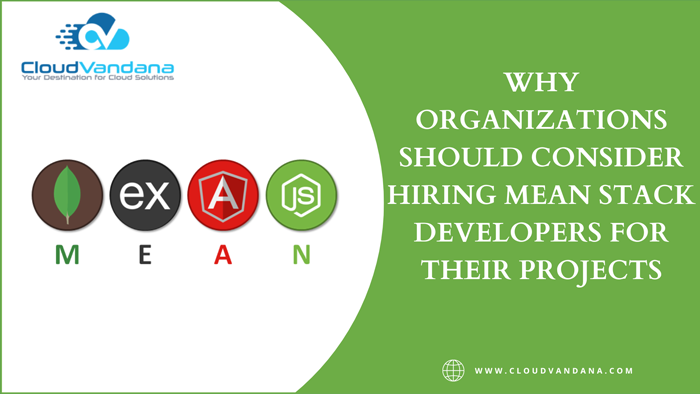
MEAN stack developers refer to professionals in a particular set of technologies, MongoDB, Expressjs, AngularJs, and NodeJS. In simple words, MEAN stack developers are like JS-based application developers. In this blog, CloudVandana, a reputed Staff Augmentation firm in India, will discuss why organizations should consider hiring MEAN stack developers for their projects. In this digital world, organizations across the globe need to adopt advanced technologies to build a product that can add true value to their targeted customer segment. In such a way, the organizations can ensure success for their business. So, companies are rapidly investing in hiring MEAN stack developers for their web development projects and cloud-based applications. MEAN Stack MEAN is a comprehensive JavaScript stack used for cloud-ready applications. It is a web development solution based on full-stack JavaScript technologies. MEAN is the abbreviation for MongoDB, ExpressJS, Angular JS development, and Node JS. This technology has introduced new ways for developing scalable web applications using robust design patterns, such as Model View Control. Components Let’s discuss the components of the MEAN stack. It is a great database program for backend applications as it is easy to scale and adaptable platform. It is an open-source cross-platform that relies on architecture made up of documents rather than tables and rows. In addition, it can manage a huge amount of data easily. It is used for modular web application development that runs on Node.js. It is a minimal and flexible server-side framework based on JavaScript. It simplifies the development process with easy functionality, helping developers to write secure, modular, and faster web applications. It is a front-end web framework with an MVC architecture that employs Ajax technologies and uses a Javascript-based program. It can rapidly develop dynamic single-page web apps. This framework has a modular structure to boost the scalability of this platform. It is an open-source and cross-platform Javascript environment for implementing the application backend in JS. It is built on Chrome’s V8 engine and designed to create complex network applications and platforms. It works as a runtime application. The Benefits Of Hiring MEAN Stack Developers Let’s discuss the details- Cost-Effective Solution Hiring a remote MEAN-Stack developer is the most trusted option for a product business that wants to build robust and secured solutions. In addition, the deployment cost is lower as the components are free and can run on any server. Cloud-Compatibility The MEAN Stack framework use modules, library functions, and various public repositories while developing web applications. This framework is cost-efficient and reduces storage space usage and device procurement costs. So, developers can create robust cloud applications using the MongoDB database management system. Ability To Deliver App Performance Node.js is the major component in MEAN Stack used for the development framework that ensures apps deliver excellent performance. MEAN Stack developers use this framework in creating dynamic websites and applications to ensure high-end results. Node.js development is easy to understand and displays better results than other programming languages. Swift Switching MEAN can be easily implemented as everything is written in a single language. As a result, it can be easily switched between the client and server. Using Node.js as the web server, there is no need to use a LAMP stack or Apache. So, full-stack developers can easily deploy the application directly on the server. Global Community Support MongoDB is a renowned NoSQL database provider. Angular JS is backed up by prominent enterprises such as Google. This technology offers advanced features in web development applications. It uses single-page applications, reducing refreshing web pages. The features have made it more popular among businesses and developers. There are various other benefits of this platform, and certified MEAN-Stack developers with rich experience can make the web project more user-friendly. Certified developers with rich experience can make the web project more user-friendly. They keep on updating themselves with all the latest technological innovations. So, they can easily implement smart features in the project to ensure their clients get an interactive and responsive website. Are you looking for the best team of MEAN Stack developers? Please feel free to schedule a consultation with CloudVandana, and stay one step ahead of your competitors. Call Us Now. Request a Free Consultation YOU MIGHT ALSO LIKE
7 ESSENTIAL THINGS TO CONSIDER BEFORE BUILDING AN APPLICATION

An application enhances the identity and brand value of an organization. So, if the organization invests in building the application mindfully, the development process becomes more accessible and successful. In this blog, CloudVandana will discuss seven essential things to consider before building an application. Let’s dive into the details- 1. Market Research Market research is the first and foremost thing before executing an app. Organizations should have clear knowledge about the latest trends in the market and the solutions that the app will provide to the customers. Proper market research will help the organization to identify the competitors, their offerings, and their strategy to market the products. The strength and weaknesses of other app developers can be identified. The view and pain points of the target market, and finally, the unique selling points of the competitors. This analysis will provide the knowledge to avoid any mistakes at the primary stage of app development. 2. Identify User Persona The user persona is the fictional representation of the ideal app user. Establishing the persona helps identify the application features and promote the product when it is ready to launch. To identify the audience’s requirements, a few personas should be defined. This helps determine the app better and solve the issues and help to achieve the goals. 3. Define The Target Audience Defining all the ideas in a few steps is the core step to ensure the application’s success. The brand needs to define the key functionalities of the app, the problem-solving capabilities, the target users, the reasons to adopt it, and the benefits that the users will get after using the app. 4. Pre-Launch Branding Pre-launch branding and web presence lead to the great success of the app. So organizations should start marketing even before the development process. Marketers should adopt effective branding strategies. The first and foremost thing is to create the brand for the app, the color, logo, and other branding efforts to enhance its existence. After creating the identity, the preferred channels should be identified to market the app. After these steps, marketers can create useful content to provide important information to the audience. 5. Monetisation Strategy After the market analysis, organizations should decide how to make money through it. The users must purchase the app from the app store to make money through it. App Monetization models can be segmented into three categories, 6. Sufficient Infrastructure And Resources After managing and planning all these, now the main part is the development and on-time deployment. So, the brand should be aware of the development time frame. So they should be ready with a team of skilled and experienced developers to launch the app on time. 7. Security Last but one of the most important things is to include a privacy policy if the app gathers sensitive information from the users. The policy should cover what information is being collected and how it is used. Most developers are more focused on the app, so the security gets ignored. But it is always recommended to focus more on implementing safety measures in the app. Are you looking for a team of skilled developers to successfully execute your app? Please feel free to schedule a consultation call with the reputed Staff Augmentation firm CloudVandana and enhance your brand. Call Now. Request a Free Consultation YOU MIGHT ALSO LIKE
10 KEY REASONS TO USE JAVA TO ENHANCE YOUR BACKEND DEVELOPMENT
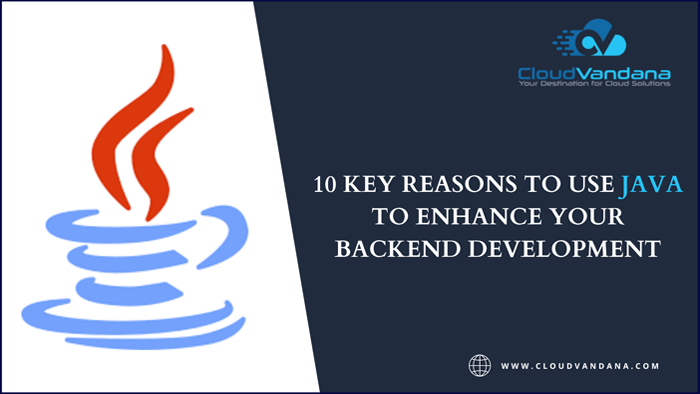
Java is a high-level, class-based, object-oriented programming language with as few implementation dependencies as possible. But why is it considered one of the most popular programming languages for backend development? In this blog, CloudVandana, a reputed Staff Augmentation firm in India, will discuss the key reasons to use Java for backend development while building a new web or mobile application. While developing a backend application, organizations need to choose the right technology and framework for further expansion. This language helps to boost production during the software or web development process. Making a contract with a reputed Staff Augmentation firm to hire the best team of developers is the best way to experience the best talent. Let’s discuss the ten key reasons to choose this framework to enhance backend development. 10 Key Reasons To Choose Java Let’s dive into the details. 1. Object-Oriented Programming Language It is an object-oriented programming language. So it has various concepts that are relatable. This framework has become more accessible, flexible, modular, and extensible. This language supports principles like Data Abstraction, Polymorphism, Encapsulation, Overloading, and Inheritance. According to the backend web developers, this makes the language as powerful as C++. 2. The Programming Language For The Enterprise It is the most used programming language for building Enterprise and web applications. Since enterprise-grade applications have heavy performance requirements, they need a technology stack to handle the activities. Enterprise apps need robust security to ensure the confidentially of data, which makes Development valuable. 3. Inspired By C And C ++ C & C ++ are very long-tenured programming languages that are the ancestors of Java And Python. Java resembles C and C++ but doesn’t have characters like pointers and multiple inheritances. So, coders who understand C and C ++ can easily adopt this framework. 4. Great Performance The Java compiler is designed for performance. The code is compiled into bytes and then compiled by the Java compiler. Before converting into machine-level code, the code runs through Java virtual machine. 5. Enhanced Growth This framework was created 24 years ago. Since then, this programming language has evolved and adapted from the beginning to fulfill every need of the latest market trends. In addition, various new features have been added with each release, so organizations across the world are becoming more interested in using this language not only for backend development but also for enterprise applications. 6. Economical And Easy To Maintain Java is open source under open JDK. Java programs are easy to develop and maintain. In addition, they can efficiently run on any JVM, so users don’t need to bear extra costs for setting up specialized environments for executing Java programs. Moreover, Java boasts good community support that helps beginners to overcome coding complexities. 7. Security Safety characteristics are built into this framework and the runtime system. Runtime checking and static type are checked at the compile time. So, it becomes challenging to seize a Java-based application from the outside. Data security is an essential part of any application. So, organizations worldwide prefer to hire expert app developers with hands-on expertise with this framework to provide a secure and robust application. 8. Easy Coding The easy coding feature defines the simplicity of a programming language. This framework has less ambiguous terminology, so anyone with basic Java knowledge can start using this framework. 9. Robust Solution Robustness means reliability. It is the most supported programming language that is robust and scalable. In addition, the automatic memory management and garbage collection features make it portable across various platforms. 10. Multithreading This programming language has multithreading capabilities so that developers can create highly interactive and responsive applications with the help of various concurrent threads of activities. The multi-threading environment supported by Java gives users a quick response time, fewer issues, multi-operations, better performance, and faster concurrent access. There are various other benefits of this framework that organizations can experience by hiring the best team of Java Developers. Are you looking for the best team of remote Java developers for a faster deployment process? Please feel free to schedule a consultation call with CloudVandana and experience the huge talent pool of remote developers in various technologies. Call us today and hire in 48 hours. Request a Free Consultation YOU MIGHT ALSO LIKE
SALESFORCE INTRODUCES COMPOSABLE STOREFRONT
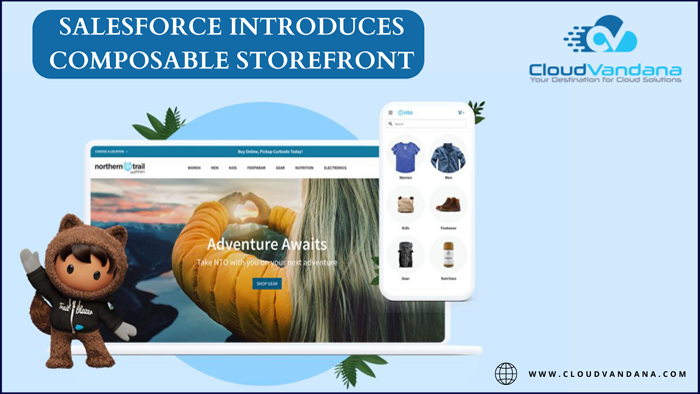
The Salesforce Composable Storefront is a customizable, digital headless storefront that provides retailers with the flexibility and agility to make any changes to their site to increase basket size, conversions, and sales with decreased costs. In this blog, CloudVandana, the reputed Salesforce partner in India, will discuss an overview of this new innovation. The contribution of headless commerce with the addition of a storefront has been adopted by numerous digital businesses, and several are already in the process of implementing headless commerce as a part of their core business. Salesforce has introduced pre-built packages specially created for headless implementations and offered several use cases with commerce partners. This includes best-in-class integrations, pricing, and implementation accelerators across the ecosystem. Salesforce is the latest mega platform to embrace MACH mania, announcing its new composable Storefront-a fully customizable and headless digital storefront that helps online retailers to make site changes with the speed and flexibility needed to increase sales, conversions, and basket size while helping to drive down costs. Let’s jump into the details to understand more about this innovation to stand out from the competition. Headless Capabilities Retailers need adaptable and flexible commerce sites to keep up with rapidly evolving customer preferences. It is a key game-changer for making omnichannel a reality for retailers. It effectively separates the front-end and back-end of an e-commerce solution, helping brands to quickly and affordably customize digital storefronts without disrupting the shopping experience. According to the latest statistics, retailers invest more in headless commerce to drive more revenues. “With customers expecting both engaging and seamless e-commerce experiences, headless architecture can help online retailers build and implement site changes with speed and agility,” said Scot Gillespie, GM of Commerce Cloud. “Salesforce’s Composable Storefront is a secure, trusted platform that empowers users to leverage headless while accelerating time to market and reducing costs.” Composable Storefront With the help of Composable Storefront, Commerce Cloud customers can implement complex development issues. Using the progressive web app(PWA) technology, businesses can boost storefront performance and engagement with a fast, app-like site experience. It decreases page load time and decreases disruption for online shoppers. Using the various packages offered by this platform, brands can easily build composable and engaging experiences with advanced search and content. This helps to reduce time spent on vendors, negotiating prices, and building custom integrations. In addition, this platform provides the ability to ship new features and updates daily with 60-second deployments. This practice helps to eliminate risk, giving developers the flexibility to execute and add new features at any time. As more channels are entering the mix, consumers are looking for the easiest paths to shop and purchase online. An efficient digital experience leads to more sales and a robust, integrated, and easy-to-manage platform, fulfilling the needs of a modern digital commerce program. With the endless support of Salesforce, enterprises can increase their growth into omnichannel strategies and leverage the capabilities of the ecosystem. Do you have any further queries, or are you looking for a reputed partner for a successful Salesforce Implementation? Please feel free to schedule a consultation call with the experts of CloudVandana and hire the best team of Salesforce professionals for a faster deployment process. Enquire Now. Request a Free Consultation YOU MIGHT ALSO LIKE
7 KEY FEATURES OF SALESFORCE SERVICE CLOUD
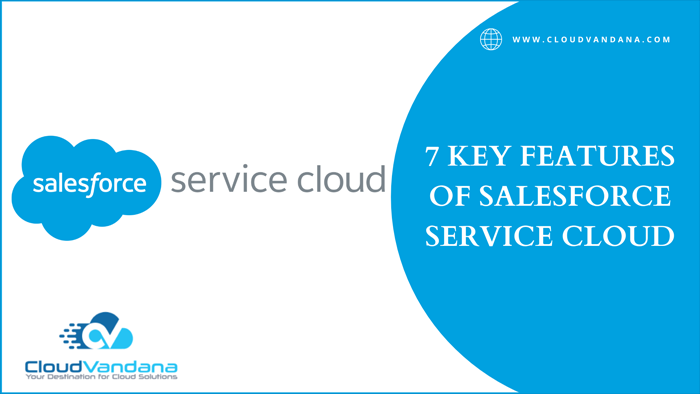
The Salesforce Service Cloud is one of the most popular and highly-rated customer service software solutions introduced by the world’s #1 CRM brand. Service Cloud integrates customer service with social networks and provides a self-service customer portal and knowledge base system. In this blog, CloudVandana will discuss seven key features of Salesforce Service Cloud. The secret of any successful business is creating more happy customers. Customers are considered the backbone of any business. So, to fulfill the demands of the customers, organizations should have a robust service infrastructure. So, the system needs to be flexible and accessible across various platforms. Salesforce Service Cloud is the best service platform in the digital world. This platform can quickly receive and respond to customer queries across different channels. This platform is supported by Artificial Intelligence and automation to put service processes on automation. Let’s look at the key features of this platform. Features Of Salesforce Service Cloud 1. Workflow Automation Workflow automation helps to automate various business processes. The feature helps to save a lot of time. Users can build and update processes properly using the Process Builder. It also accepts request approvals. Users need to define the steps required in the approval process. Users can automate various tasks like responding to emails, field updates, and assignment of tasks. 2. Omni Channel Routing With the help of Omni Channel routing, users can make service tasks efficient. In addition, it provides detailed analytics regarding the workforce’s working conditions, habits, and availability. The service cloud assigns tasks to the service agents depending on their skills and availability. 3. Lightning Service Console The Lightning Service Console helps the service team to deliver the best experience to the customer. The sales team can experience a unified view of the customer’s journey in one place. The customizable dashboard allows the service executives to access and use the data efficiently. 4. Case Management Fast and timely addressing customer issues are important. With the help of Case Management, the service executives would have all the related information and the right solutions at their disposal. The Salesforce Einstein AI automatically assigns the cases to the concerned service agents. It gives a broad picture of the customer in terms of activity timeline, emails, etc. It also provides alerts and updates for customer activity. 5. Service Cloud Analytics Service Cloud Analytics provides the power of data to the users to track the latest trends, KPIs, and performance metrics. So the service team can receive the required information regarding customer behavior and personal details to help create better services faster. 6. Telephony Integration The calling process is very important in customer service, so the popularity is increasing drastically for good CTI integration in Service Cloud offers many good features. Users can make a call with just a click. The Telecaller executives can get all the customer-related information before picking up the call. Other functions like transferring the call to other agents, conferencing it, putting it on hold, etc., can be done through a centralized portal within the Service Console. 7. Service Cloud Self-Service Portals And Communities Users can build very effective and functional Self-service portals and communities. It has two benefits. It can free up the service agents from answering the most common queries. Second, it allows the customers to help themselves. Customers can interact and help each other. According to the customer data, it can integrate a chatbot and update the contents using Einstein Analytics. There are numerous benefits of the Salesforce platform that users can experience after implementing this solution to the workflow. Are you looking for a reputed Salesforce partner for a successful implementation and maintenance process? Please feel free to schedule a consultation call with CloudVandana, a reputed Salesforce partner in India, and get the full ROI of your Salesforce investment. Call Now. Request a Free Consultation YOU MIGHT ALSO LIKE
KEY TIPS FOR A SUCCESSFUL SALESFORCE INTERVIEW
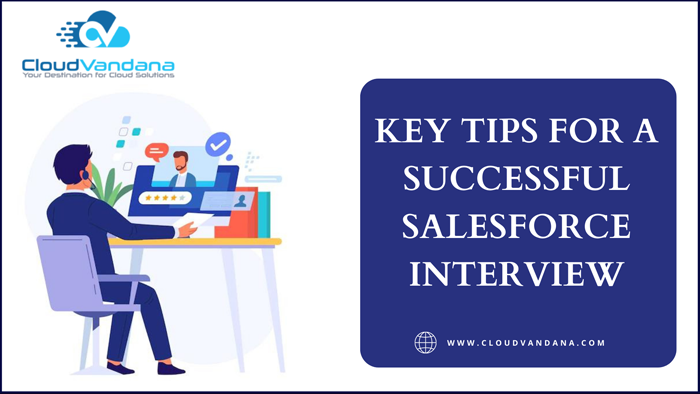
Salesforce and many IT industries have introduced remote working and interviewing post-pandemic era. The pandemic has changed the way we live and work. Many companies have put a freeze on recruitment, but most companies are continuing to hire to prevent a slowdown. In this article, CloudVandana, a reputed Salesforce partner in India, will discuss key tips for a successful Salesforce interview. So the candidates, who have been looking for a new Salesforce role for a long time, it is great news for them. There are plenty of opportunities available with a fast remote recruitment process. So, along with your preparation, let’s quickly look at the tips for a perfect virtual interview. Successful Salesforce Interview 1. Know The Difference There are a few differences between interviewing in person and virtual interviews. So, well-rehearsed candidates at in-person interviews do not necessarily mean they will rock in the virtual interview. So they should be well prepared before sitting for the Salesforce interviews. They might feel slightly uneasy when taking part in an online interview. This virtual interview platform is new territory, so candidates must handle each step efficiently. Following every step and process with efficiency will help them to achieve their desired role. 2. Location Location is not a bar in this virtual interview process. Candidates can join the virtual interview from any part of the world. They just need to ensure the background is proper and the light is sufficient so the interviewer can see the face clearly during the virtual interview process. In addition, there should not be any object or person which can create a distraction. The candidates should double-check if the whole setup is proper or not to avoid any challenges during the interview. 3. Camera Ready After the checkups mentioned above, the candidates can select the outfits. Though the interview will be conducted in the comfort of their homes, the candidates must follow a few rules and regulations for their dress code. They should dress properly, like an interview in person or in regular office interviews. In addition, wearing formal shoes during the virtual interview will help candidates to enter more into the interview headspace. Other Important Tips These essential tips will take the candidates toward a successful interview. 1. Use of Hands- Moving the hands along with the speech is a great way to communicate. So candidates should move or use their hands wisely for more confidence and enhanced communication. In addition, they should hear the interviewer properly with full attention and start answering after their speech is over. 2. Keep Little Difference- Candidates should keep a minimum gap between them and the system during the interview. It is recommended to push the chair a little back further than they place it during their normal work. 3. Be Confident- Candidates should be confident enough to handle little challenges that may occur sometimes. But in a more complex situation, they should state clearly to the interviewer if they don’t have enough knowledge or confidence. This will help them to maintain transparency, which can be a positive sign. 4. Look Start At The Camera-The interviewers always feel connected to the candidate if the webcam is on during the virtual interview. So the candidates should look straight at the camera for better interaction. It is advisable to avoid wearing a headset as this can be distracting. So, be confident, and rock!! Are you looking for Salesforce resources to enhance your Salesforce projects? Please feel free to schedule a consultation call with CloudVandana and hire the best team of remote developers for your ongoing and upcoming projects. Call us now. Request a Free Consultation YOU MIGHT ALSO LIKE






